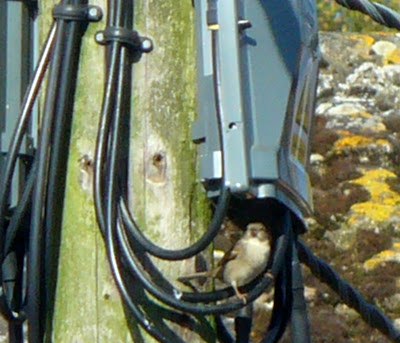As I sit here, I can see our contribution to the (hopeful) recovery of the UK's beleagured House Sparrow (Passer domesticus) population flitting about in the garden near the seed feeder - including fledged young still fluttering for food near their parents. There is no evidence of sparrows nesting in the garden, but just outside the front of our house, they can be seen being particularly resourceful...
Of course, sparrows are not the only birds using the garden - the bath has been very popular with bickering, and occasionally even English-style queueing.
 |
| Blackbird (Turdus merula) drinking from the bird-bath |
 |
| Wood Pigeon (Columba palumbus) hogging the bird-bath - the passerines can be heard shouting nearby... |
 |
| Meadow Clary (Salvia pratensis) - extremely rare in Britain, we now have one plant in our tiny wild meadow! Hoping to collect seed... |
 |
| An ant's-eye view of the burnet-like Acaena planted where a patio slab has been removed. |
 |
| Partly added as a pretty picture, here is a spider (Metellina sp. I think) building a web inside a foxglove (Digitalis purpurea) flower, hoping to catch those flighty nectar-feeders. |
 |
| One of our many many garden ants (Lasius sp.) tending, maybe 'milking' honeydew from, A Brown Peach Scale insect (Parthenolecanium corni). |
 |
| The diversity of arachnid forms writ large - a Trombidium mite and a Pardosa wolf-spider |
 |
| Shhh... the spiderlings are sleeping... |
 |
| What was that? They've started to stir... |
 |
| Aaaagh, run for it! |
 |
Some bungee from the bottom of the nursery web, others make a run for it - the one top right is winning... |
| Oh, it wasn't anything dangerous - they start returning to the web to reform the ball, some climbing back up bungee-ropes, others crawling back along various strands. If it had been a predator or other threat, the chances are some would have escaped as they scatter in all directions. |
And so, there is space for a wide range of species even in our fairly small garden - it just needs some thoughtful planting, a few other features (feeders, bird-baths, a pond is in the construction stage), diversity of structure, and a willingness to leave things alone as much as possible. This is an important little bit of nature conservation most of us can do to some extent, and if you enjoy recording species, gardens can be important sources of biological records (in the UK there are popular garden-based bird and, to a lesser extent mammal, recording schemes designed for non-specialist volunteers). Anyhow, enough from me today - more soon, and eventually I imagine I will eventually compile a garden species list...

No comments:
Post a Comment